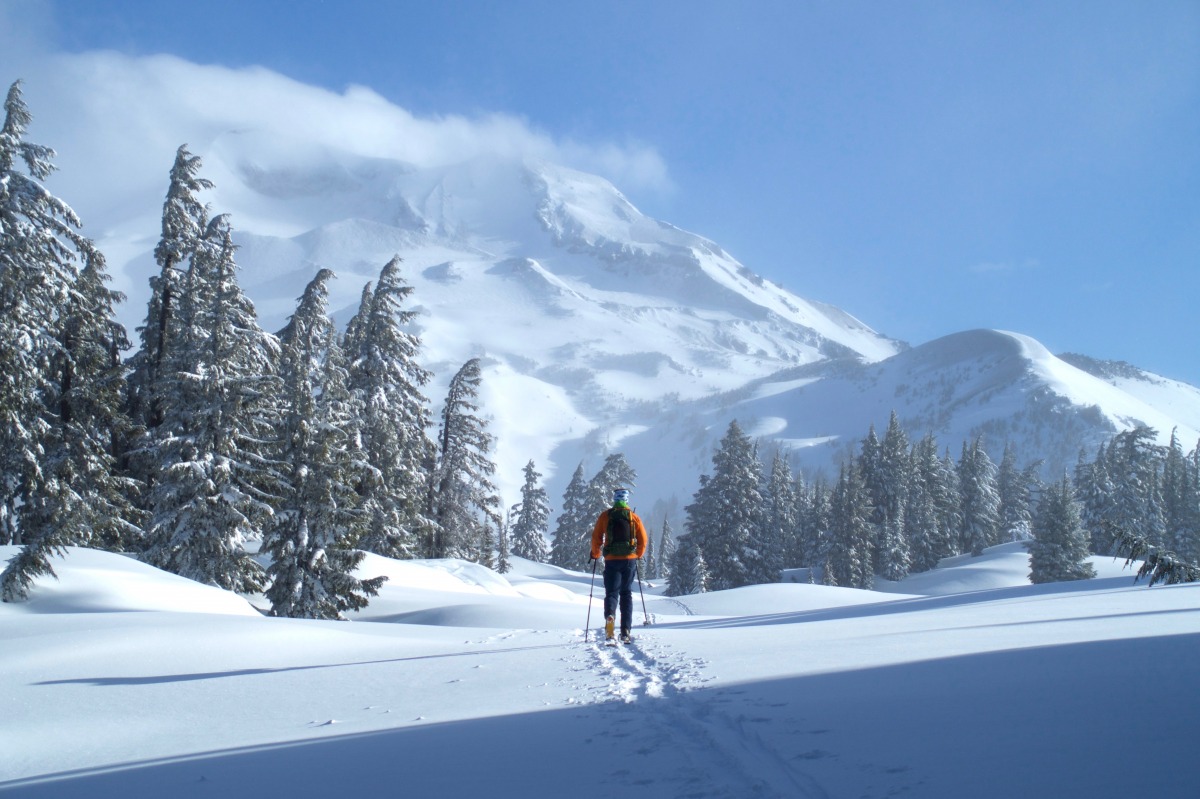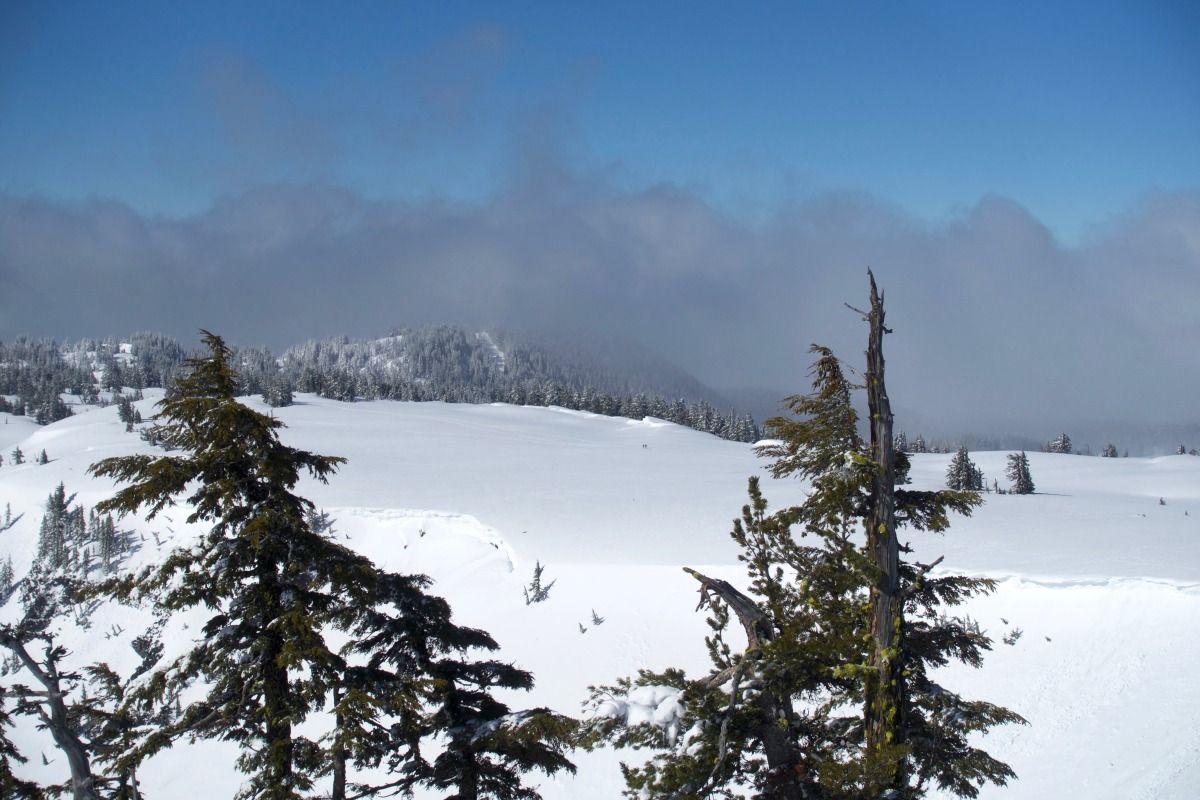It has been, thankfully, a wet spring in the PNW. Which, for some readers, means nothing, as the skis are storage-waxed for the off-season. For those trying to eke out more turns and vert, and you’re not eyeing Denali, the PNW volcanoes are the low-hanging fruit. Before the moist April, then May, and now a drizzly early June, a long spring ski season seemed more wishful thinking than anything else.
We’ve had a welcome refresh the past few months.

A late May return of winter in the PNW.
During a recent ski trip on the South Sister, I ran into someone claiming our local county here in Oregon (Deschutes) was notching over 150% for the current basin-wide snow water equivalent (SWE) relative to the 1991-2020 median. Although the snowpack superficially seemed robust, the 150% mark appeared optimistic. A check of the SNOTEL data confirms and even exceeds that casual estimation I received on the skintrack. I’m now seeing percentages of 177% for the Upper Deschutes and Crooked River basin. (The SWE stood at 83% on April 16th for that basin.)
If you are heading to Oregon or on your way north to ski the hills in Washington, this is all good news. Washington’s SWE totals have been consistently above those in Oregon throughout the winter and spring.
More stats: according to drought.gov, my county experienced the 7th wettest April over the past 128 years and the 31st driest year over the same period (Jan-April).
Although the spring into summer ski season promises to be of the rosy bent, all is not rosy: 81.3 % of Oregon is currently abnormally dry (which has an official statement of “Ski season is impacted.” Further, 47.2% of the state remains in extreme drought.
In other words, for now, the spring volcano season sides on the glass half full side of the optimism-pessimism perspective.

Not all who wander are lost. Skinners finding their way to some solitude.
In the Media:
A few items have caught my attention. The first piece is the recently released documentary The Sanctity of Space. In short, the documentary follows Renan Ozturk, Freddie Wilkinson, and Zack Smith and their near-obsessive quest to climb the “Tooth Traverse” deep in the Ruth Gorge of the Alaska Range. (A review of the film is forthcoming.) The show’s real star, however, is Bradford Washburn. Washburn is the storied head of the Boston Museum of Science, gritty first-ascensionist, and aerial photography virtuoso. Ozturk and Wilkinson, the co-directors, masterfully blend their climbing narrative with Washburn’s love affair with the mountains. Ozturk and Wilkinson credit Washburn for inspiring the vision for something as audacious as the Tooth Traverse. In this film, you’ll find a compelling story that is teased along with a deep (and deserved) piety for Washburn.
Unless you live where the film is screening, you can find it for rent or purchase on many streaming services.
I recently found a compelling piece in the Adventure Journal online titled “Knowing When to Turn Back.” Although not a deep meditation on the topic, the article incorporates the sunk cost fallacy in proving the point that past costs, be they financial or emotional or time, for example, should not influence rational decision making in the present, especially during a crisis. I’d say the story borders on thought piece but leaves the reader with the valuable imprint that calling it a day or turning back while adventuring has no shame. Knowing when to pull the plug often illustrates high functioning self and situational awareness.
And early this AM, my eyes got the best of me when an image in the NYT of a surfer on Tahiti’s famed Teahupoo became clickbait. The article’s title sums up the author’s central thesis: “The (No Longer) Secret World of Surf Spots—Publicizing certain surf spots, especially off the beaten path, is similar to violating the first rule of Fight Club. Instagram and some new surfers have threatened that reverence.”
That first rule (and the second rule, in case you forget the first rule) is you do not talk about Fight Club. I had to look that up; I never saw Fight Club. Brad Pitt lost me after A River Runs Through It.
Here’s a long quote from the NYT’s piece:
“But then Instagram came along. Its geotagging feature can pinpoint the exact location of a photo. It has affected many natural spaces, from once quiet national parks such as Joshua Tree to formerly hidden waterfalls everywhere, which are now overrun with crowds, cars, noise and trash, leading to rules, fences and even closures.
“Surfing’s response to the phenomenon was always going to be a bit different, though. The sport has treated both knowledge and waves, whether in San Diego or semirural Oregon, as things that are earned, not given — the way fishermen hold dear the locations of secret fishing holes.
“Exposing a well-kept wave brings attention, which brings crowds. An overcrowded wave means fewer waves for everyone, and the one-surfer-per-wave etiquette tends to break down, leading to accidents and confrontations. Some surfers have long guarded against this situation by enforcing their own rules at their local spots, deciding who can catch waves and making those rules crystal clear to newcomers.”
The easy thing would be to blame social media, particularly the visually based Instagram. But spraying about “secret” spots in the ski/riding world has been ongoing in print or video/film, for decades. Yet to say this story didn’t catch my attention and make me think of my complicities would be disingenuous.
Last week, when writing about Steens Mountain, I waffled about disclosing that the BLM will provide the key to the locked north gate——despite publically available information on their website. I also posted an image of some fine skiing in that zone, but I decided to leave precise access info and location semi-cryptic. Was I revealing a secret? Maybe I should have included more information or even less?
In any event, I recognize that some zones require a level of discreteness regarding location and access. The title of the Ozturk and Wilkinson film noted above reminds us that some spaces deserve our reverence and gentle touch when geotagging on social media or including an image with tell-all landmarks.
I’ve not quite seen all-out localism while backcountry skiing. I assume others have. But Scarcity is a thing.
Jason Albert comes to WildSnow from Bend, Oregon. After growing up on the East Coast, he migrated from Montana to Colorado and settled in Oregon. Simple pleasures are quiet and long days touring. His gray hair might stem from his first Grand Traverse in 2000 when rented leather boots and 210cm skis were not the speed weapons he had hoped for. Jason survived the transition from free-heel kool-aid drinker to faster and lighter (think AT), and safer, are better.
